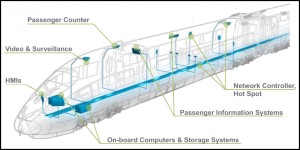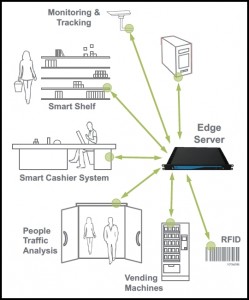Edge computing adds virtualisation and hyperconvergence: Part 2

Bob Emmerson
Part 1 of “Edge Computing Adds Virtualisation and Hyperconvergence” outlined a development that looks set to have wide-ranging implications for the future of IoT. That probably sounds like more hype, so let’s cut to the chase and take a look at an intrinsic issue that this development has addressed. Right now the IoT infrastructure is not fit for purpose, i.e. it cannot deliver the full potential of the IoT, one example being the proliferation of OT silos, says Bob Emmerson.
The following schematic symbolises a retail outlet having six applications: monitoring and traffic; smart shelves, smart cashless system, people traffic analysis, vending machines and RFID. The applications are typical for the sector, but in this case there is one, very significant difference. Normally they would be silo-type OT apps, i.e. they would be separate solutions running on six individual platforms, e.g. Windows PCs.
However a software-defined edge server or intelligent gateway employing virtualisation and hyperconvergence technology can enable multiple virtual machines (VMs) to aggregate all the application data on a single, low-cost hardware platform. Therefore the hardware and maintenance cost savings for retail organisations that might have hundreds or even thousands of outlets is very significant. Moreover there is an additional big business bonus: the same platform can process and analyse all the incoming data, thereby delivering insightful intelligence to the local management in the moment.
Part of a much bigger picture
Virtualisation at the edge enables best IT management and security practice to be employed over the whole IoT infrastructure from a single pane of glass. That is an IT term used to indicate the ability to integrate information from varied sources across multiple applications and environments into a single display. It is something that enterprise IT takes for granted when VMs are employed in data centres, but it represents a ground-breaking development when applied to micro data centres and IoT infrastructures.
The resulting OT functionality includes the ability to on-board edge systems and their connected devices, collect data, and analyse data streams to determine the operational health and status of the system or device. It also detects operational anomalies and takes action in real time. In a nutshell, virtualisation puts IT in charge of unified IoT infrastructures.
A picture that includes multiple operating systems
The apps in the previous hypothetical retail scenario would typically operate on Windows PCs, but in an industrial transportation scenario such as that of trains shown in the next schematic the applications would normally run on different hardware platforms and operating systems.
Moreover some of the apps would be mission-critical. Therefore it is clear that there is a need to enable a unified view of the performance of the various on-board heterogeneous systems would be a tall, expensive order. However, it is equally clear that virtualisation can provide the requisite single-pane-of-glass monitoring and management functionality.

Typical applications running on different platforms include: control and monitoring; communication; predictive maintenance; ticketing; passenger information & entertainment; monitoring & tracking; people counting; security & surveillance; and logistic & supply chain. Schematic courtesy Eurotech.
Conclusions
Moving intelligence to the edge has to be an IT / OT partnership play. In this case it involves the IT virtualisation technology of VMware and Eurotech’s OT experience, which is encapsulated in the intelligent gateways and edge servers. They are ruggedised, application-optimised hardware platforms that function as I/O centric IoT gateways or as micro data centres at the edge, without the need for the air-conditioned environments of large centralised facilities.
The author of this blog is Bob Emmerson, freelance IoT writer and commentator
Comment on this article below or via Twitter @IoTGN

